Abstract
Immunoglobulin A (IgA) antibodies reactive with Streptococcus mutans MT3 cells (serotype c) were sought, using an indirect enzyme-linked immunosorbent assay, in the saliva of humans who either harbored or did not harbor detectable levels of this organism. Samples of unstimulated whole saliva from three adults and one child who were infected with S. mutans contained IgA which bound to MT3 cells. Saliva samples of two adults studied also contained IgA which reacted with S. mutans strains of serotypes e, g, a, and b, the latter two of which are rarely isolated from humans. The saliva of three children who did not harbor detectable levels of S. mutans and of three of five predentate infants also contained IgA reactive with MT3 cells. The latter observation is of special interest since S. mutans does not colonize the mouth before eruption of teeth. Thus, the presence of salivary IgA reactive with S. mutans cells is not necessarily related to present or past infection by this organism. Absorption with MT3 cells markedly reduced the reactivity of adult saliva without greatly altering the total concentration of IgA present; this suggests that the IgA was not binding to S. mutans MT3 cells via Fc receptors. The possibility that the antibodies which reacted with S. mutans MT3 may have been induced to other bacteria with cross-reactive antigens was supported by the finding that absorption of saliva with mixed bacterial growth derived from common dairy products significantly reduced its reactivity. Absorption experiments further suggested that a significant portion of the salivary IgA antibodies was binding to glucans on the cell surface.
Full text
PDF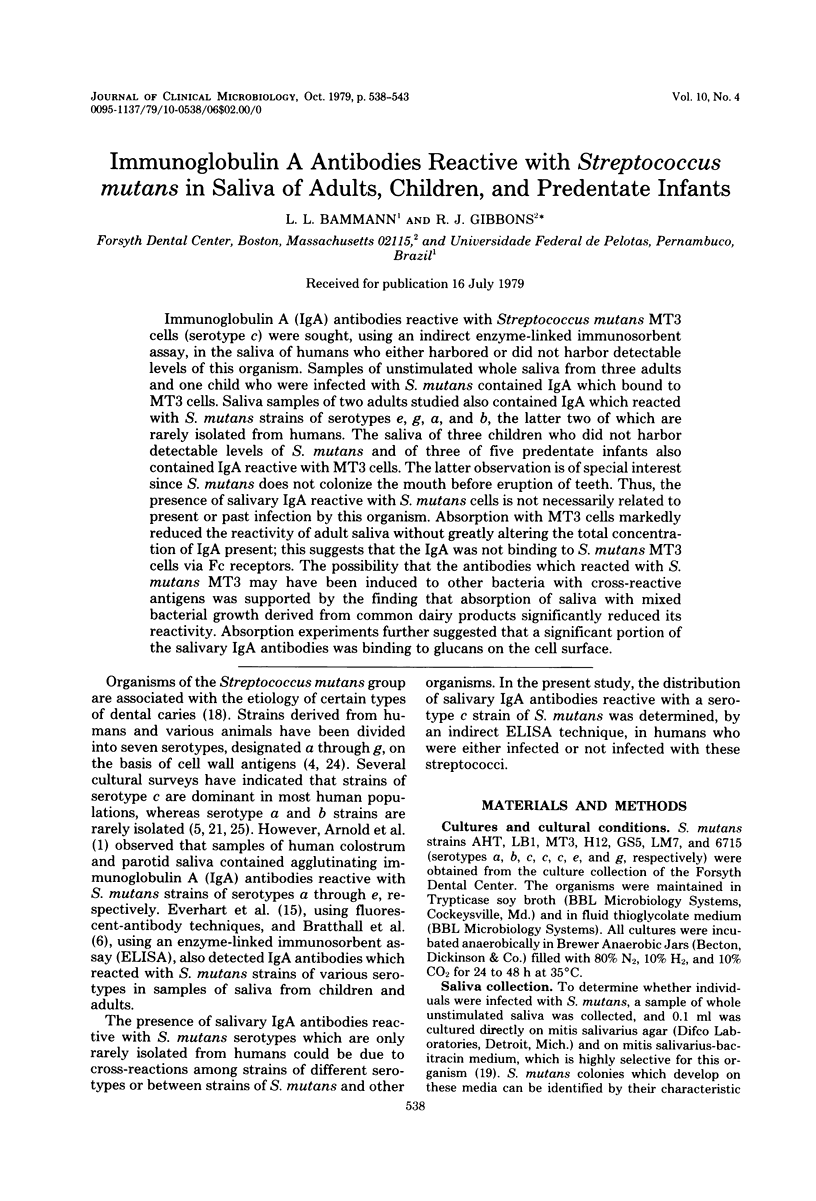
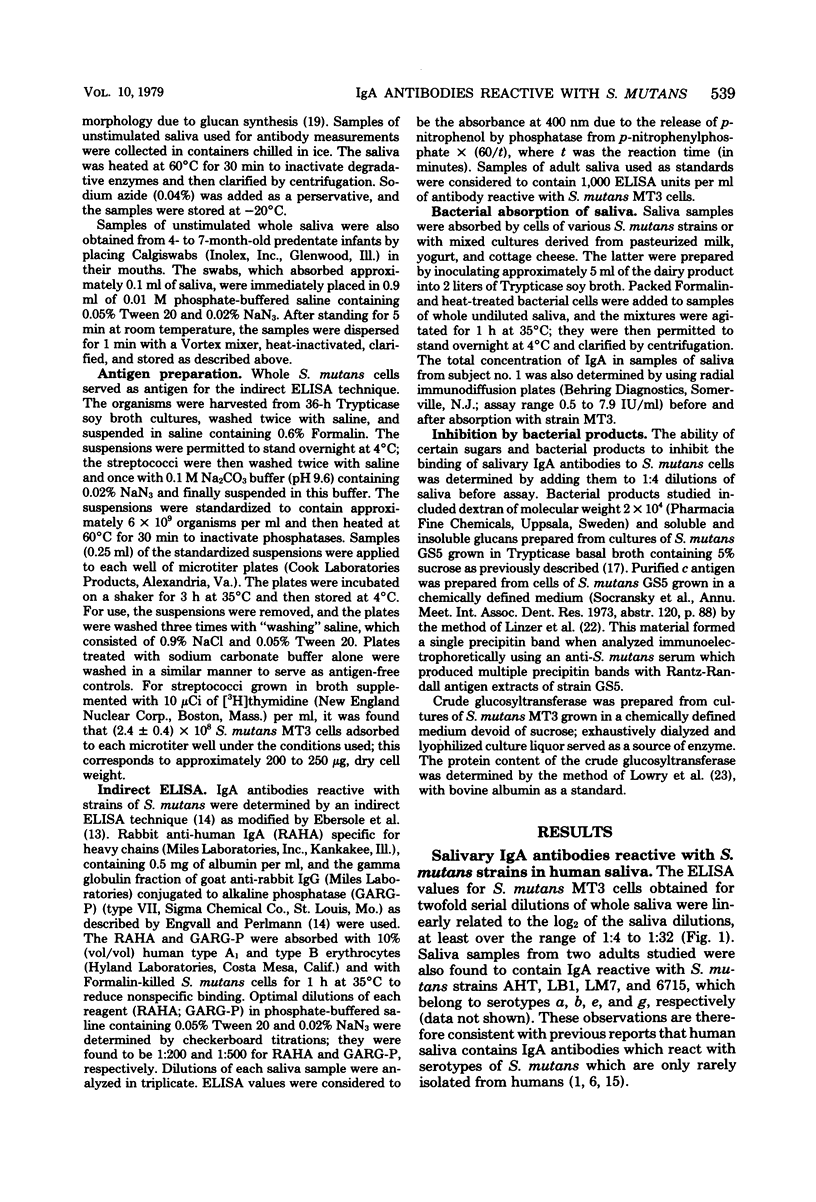
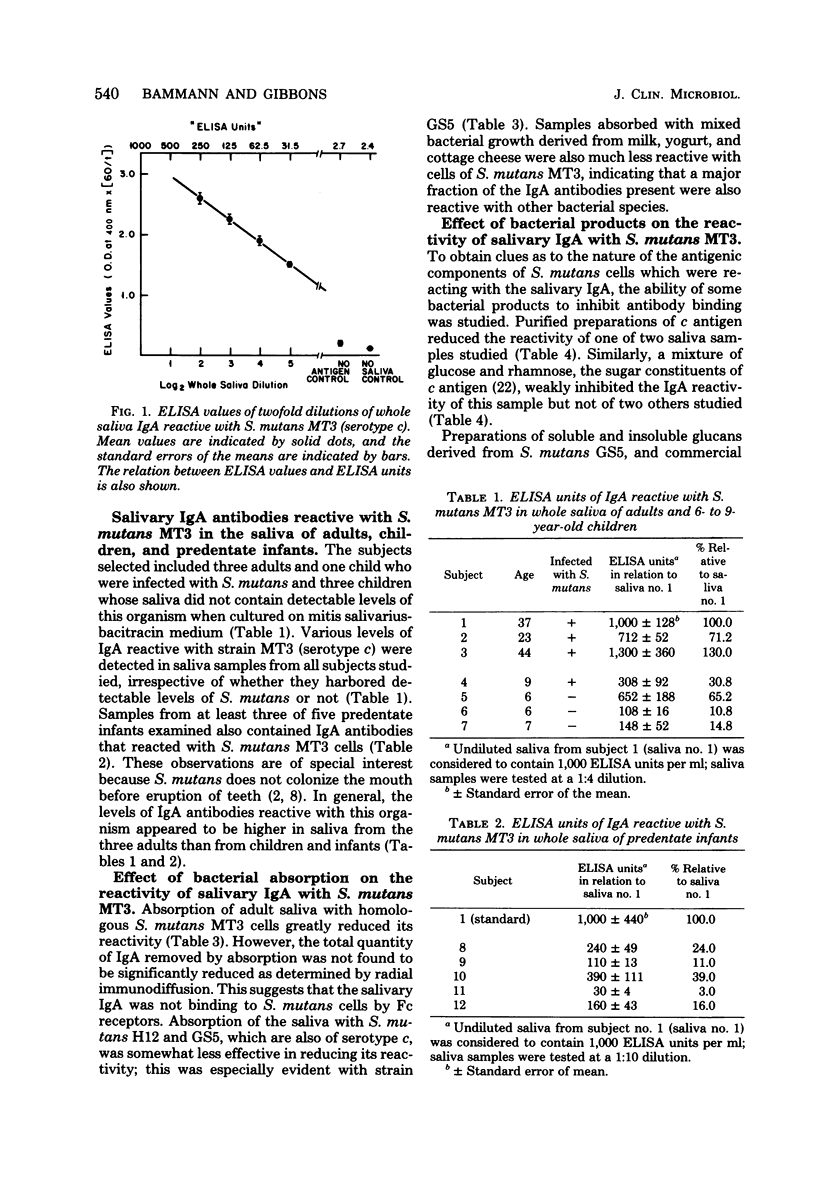
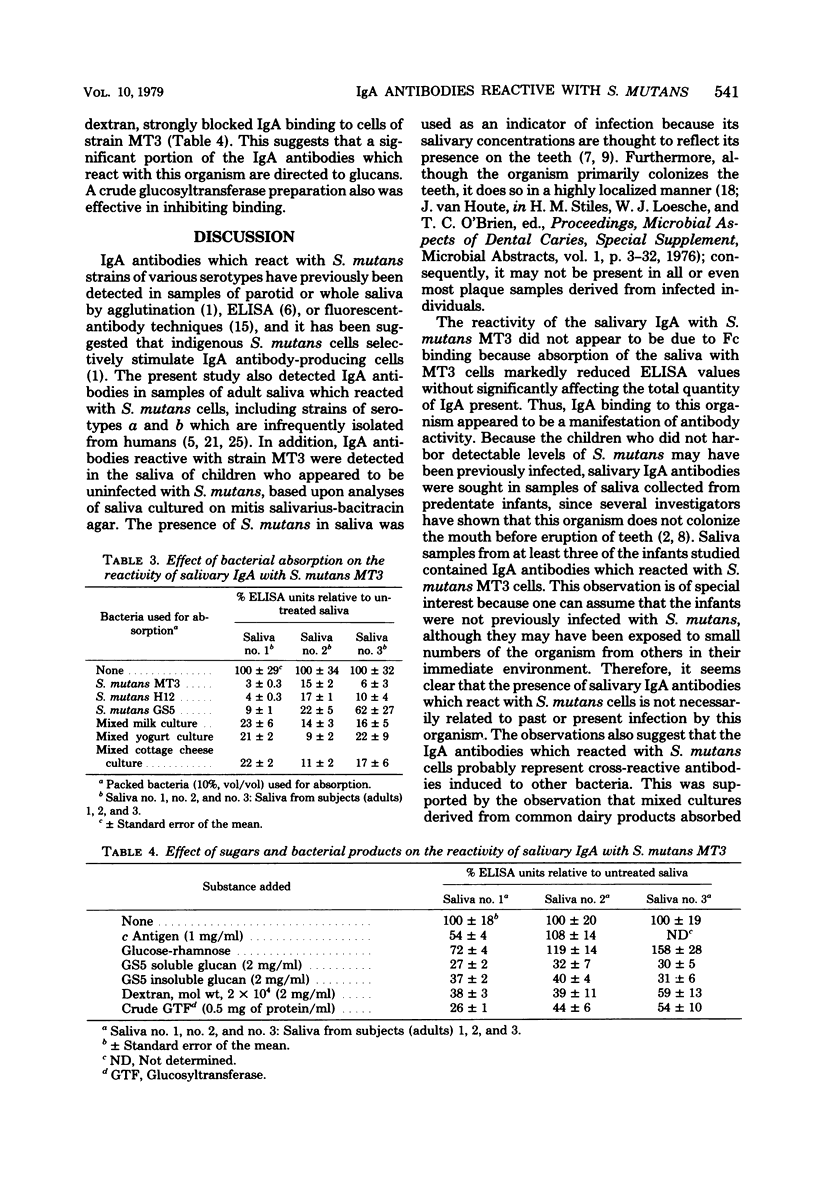
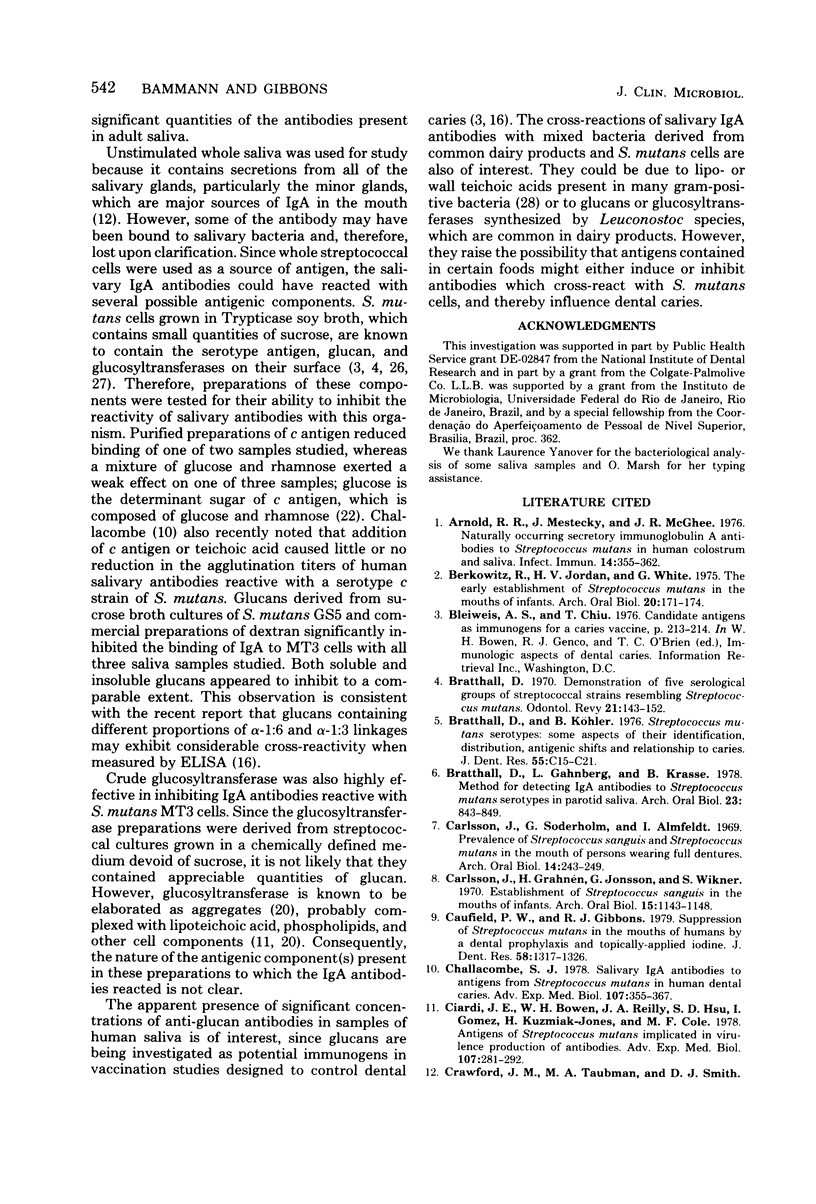

Selected References
These references are in PubMed. This may not be the complete list of references from this article.
- Arnold R. R., Mestecky J., McGhee J. R. Naturally occurring secretory immunoglobulin A antibodies to Streptococcus mutans in human colostrum and saliva. Infect Immun. 1976 Aug;14(2):355–362. doi: 10.1128/iai.14.2.355-362.1976. [DOI] [PMC free article] [PubMed] [Google Scholar]
- Berkowitz R. J., Jordan H. V., White G. The early establishment of Streptococcus mutans in the mouths of infants. Arch Oral Biol. 1975 Mar;20(3):171–174. doi: 10.1016/0003-9969(75)90005-9. [DOI] [PubMed] [Google Scholar]
- Bratthall D. Demonstration of five serological groups of streptococcal strains resembling Streptococcus mutans. Odontol Revy. 1970;21(2):143–152. [PubMed] [Google Scholar]
- Bratthall D., Gahnberg L., Krasse B. Method for detecting IgA antibodies to Streptococcus mutans serotypes in parotid saliva. Arch Oral Biol. 1978;23(10):843–849. doi: 10.1016/0003-9969(78)90285-6. [DOI] [PubMed] [Google Scholar]
- Bratthall D., Köhler B. Streptococcus mutans serotypes: some aspects of their identification, distribution, antigenic shifts, and relationship to caries. J Dent Res. 1976 Apr;55(Spec No):C15–C21. doi: 10.1177/002203457605500308011. [DOI] [PubMed] [Google Scholar]
- Carlsson J., Grahnén H., Jonsson G., Wikner S. Establishment of Streptococcus sanguis in the mouths of infants. Arch Oral Biol. 1970 Dec;15(12):1143–1148. doi: 10.1016/0003-9969(70)90005-1. [DOI] [PubMed] [Google Scholar]
- Carlsson J., Söderholm G., Almfeldt I. Prevalence of Streptococcus sanguis and Streptococcus mutans in the mouth of persons wearing full-dentures. Arch Oral Biol. 1969 Mar;14(3):243–249. doi: 10.1016/0003-9969(69)90226-x. [DOI] [PubMed] [Google Scholar]
- Caufield P. W., Gibbons R. J. Suppression of Streptococcus mutans in the mouths of humans by a dental prophylaxis and topically-applied iodine. J Dent Res. 1979 Apr;58(4):1317–1326. doi: 10.1177/00220345790580040301. [DOI] [PubMed] [Google Scholar]
- Challacombe S. J. Salivary IgA antibodies to antigens from Streptococcus mutans in human dental caries. Adv Exp Med Biol. 1978;107:355–367. doi: 10.1007/978-1-4684-3369-2_41. [DOI] [PubMed] [Google Scholar]
- Ciardi J. E., Bowen W. H., Reilly J. A., Hsu S. D., Gomez I., Kuzmiak-Jones H., Cole M. F. Antigens of Streptococcus mutans implicated in virulence--production of antibodies. Adv Exp Med Biol. 1978;107:281–292. doi: 10.1007/978-1-4684-3369-2_33. [DOI] [PubMed] [Google Scholar]
- Ebersole J. L., Taubman M. A., Smith D. J., Crawford J. M. Characterization of immunoglobulin-containing cells in the submandibular gland of the rat after local immunization. Adv Exp Med Biol. 1978;107:155–164. doi: 10.1007/978-1-4684-3369-2_19. [DOI] [PubMed] [Google Scholar]
- Engvall E., Perlmann P. Enzyme-linked immunosorbent assay, Elisa. 3. Quantitation of specific antibodies by enzyme-labeled anti-immunoglobulin in antigen-coated tubes. J Immunol. 1972 Jul;109(1):129–135. [PubMed] [Google Scholar]
- Everhart D. L., Rothenberg K., Carter W. H., Jr, Klapper B. The determination of antibody to Streptococcus mutans serotypes in saliva for children ages 3 to 7 years. J Dent Res. 1978 Apr;57(4):631–635. doi: 10.1177/00220345780570041701. [DOI] [PubMed] [Google Scholar]
- Genco R. J., Evans R. T., Linzer E. R., Hall R., Emmings F. G., Huis J. H., Veld J. H. Antigenicity and immunogenicity of cell-associated glucans from Streptococcus mutans. Adv Exp Med Biol. 1978;107:783–790. doi: 10.1007/978-1-4684-3369-2_88. [DOI] [PubMed] [Google Scholar]
- Gibbons R. J., Nygaard M. Synthesis of insoluble dextran and its significance in the formation of gelatinous deposits by plaque-forming streptococci. Arch Oral Biol. 1968 Oct;13(10):1249–1262. doi: 10.1016/0003-9969(68)90081-2. [DOI] [PubMed] [Google Scholar]
- Gibbons R. J., van Houte J. Dental caries. Annu Rev Med. 1975;26:121–136. doi: 10.1146/annurev.me.26.020175.001005. [DOI] [PubMed] [Google Scholar]
- Gold O. G., Jordan H. V., Van Houte J. A selective medium for Streptococcus mutans. Arch Oral Biol. 1973 Nov;18(11):1357–1364. doi: 10.1016/0003-9969(73)90109-x. [DOI] [PubMed] [Google Scholar]
- Harlander S. K., Schachtele C. F. Streptococcus mutans dextransucrase: stimulation of glucan formation by phosphoglycerides. Infect Immun. 1978 Feb;19(2):450–456. doi: 10.1128/iai.19.2.450-456.1978. [DOI] [PMC free article] [PubMed] [Google Scholar]
- Keene H. J., Shklair I. L., Mickel G. J., Wirthlin M. R. Distribution of Streptococcus mutans biotypes in five human populations. J Dent Res. 1977 Jan;56(1):5–10. doi: 10.1177/00220345770560011101. [DOI] [PubMed] [Google Scholar]
- LOWRY O. H., ROSEBROUGH N. J., FARR A. L., RANDALL R. J. Protein measurement with the Folin phenol reagent. J Biol Chem. 1951 Nov;193(1):265–275. [PubMed] [Google Scholar]
- Linzer R., Gill K., Slade H. D. Chemical composition of Streptococcus mutans type c antigen: comparison to type a, b, and d antigens. J Dent Res. 1976 Jan;55:A109–A115. doi: 10.1177/002203457605500103011. [DOI] [PubMed] [Google Scholar]
- Perch B., Kjems E., Ravn T. Biochemical and serological properties of Streptococcus mutans from various human and animal sources. Acta Pathol Microbiol Scand B Microbiol Immunol. 1974 Jun;82(3):357–370. doi: 10.1111/j.1699-0463.1974.tb02338.x. [DOI] [PubMed] [Google Scholar]
- Qureshi J. V., Goldner M., Riche W. H., Hargreaves J. A. Streptococcus mutans serotypes in young schoolchildren. Caries Res. 1977;11(3):141–152. doi: 10.1159/000260260. [DOI] [PubMed] [Google Scholar]
- Spinell D. M., Gibbons R. J. Influence of culture medium on the glucosyl transferase- and dextran-binding capacity of Streptococcus mutans 6715 cells. Infect Immun. 1974 Dec;10(6):1448–1451. doi: 10.1128/iai.10.6.1448-1451.1974. [DOI] [PMC free article] [PubMed] [Google Scholar]
- Wicken A. J., Knox K. W. Lipoteichoic acids: a new class of bacterial antigen. Science. 1975 Mar 28;187(4182):1161–1167. doi: 10.1126/science.46620. [DOI] [PubMed] [Google Scholar]


